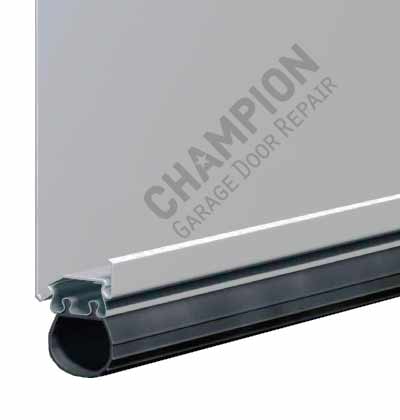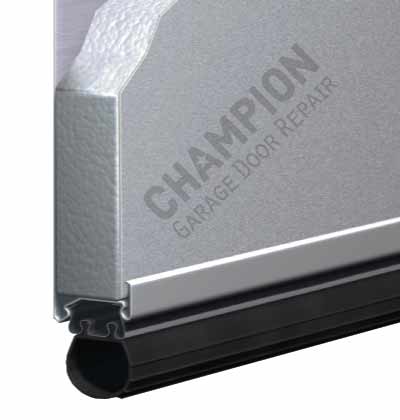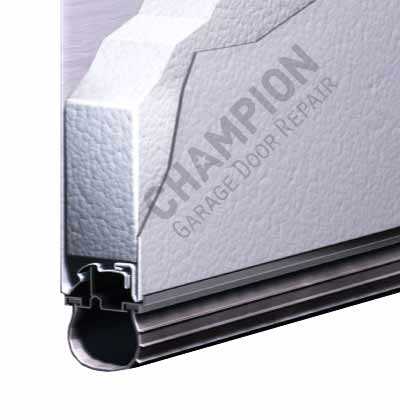Understanding the distinctions between various types of doors, their pros and cons, can assist you in making informed decisions when replacing or installing a garage door. There are three types of garage doors: regular, poly back, and steel back. Let’s examine the differences between them.
Regular Uninsulated Garage Doors
Uninsulated garage doors are typically made from a single layer of material, often steel or wood. While they are more affordable than insulated garage doors, regular steel doors are prone to damage, and their lack of support may cause them to fold and dent upon impact. Even a minor collision with a vehicle, bicycle, stray ball, or debris could result in damage to the door’s sections.

This vulnerability extends to common breakdowns such as garage door off track, a broken cable, or a broken spring, as they can bow or buckle more easily. Consequently, uninsulated garage doors may require more frequent repairs and panel replacements to maintain appearance and functionality, although proper support struts can help address and mitigate these issues.
Insulated Poly Back Garage Doors
Poly back garage doors are made with an exterior layer of steel and an interior layer of insulation, hence the term “2 layers.”

While they provide good insulation for your garage, the insulation material is exposed from the back. This makes the garage door and insulation more vulnerable for a few reasons:
- Age and Wear: The insulation material is more prone to deterioration due to age and wear. As the insulation ages, it may become brittle and break down.
- Excessive Vibrations: The insulation being exposed to constant vibrations from the movement of the door can lead to increased noise during operation and may cause the insulation to detach over time.
- Fire Vulnerability: The insulation material can be highly flammable and can contribute to the spread of fire if ignited. This can pose a significant risk to the safety of occupants and the property.
- Moisture: The insulation may get wet or exposed to high humidity levels, it can become damp and lose its insulating properties. This can cause it to break down and fall off.
- Vermin Infestation: Rodents, insects, and other pests can cause damage to the insulation material by burrowing through it or using it as nesting material. This can cause the insulation to break down.
- Lack of Support: The weight of the insulation can cause the door’s exterior layer of steel to crack and fail over time, resulting in the door sections buckling under the weight.
Insulated Steel Back Garage Doors
Steel Back garage doors, also known as sandwich doors, consist of three layers of material. These doors typically have steel or wood exteriors with insulation injected between them. The added interior layer seals the insulation, improving its durability. Compared to regular and poly back doors, three-layer insulated garage doors offer better protection against weather, reduce sound transmission, and are more resistant to damage. This durability may result in fewer repairs and panel replacements over time.

While three-layer insulated garage doors are more expensive upfront and may incur higher repair and maintenance costs if they break, they offer numerous benefits that justify the additional expense. These benefits include:
- Durable and Quiet Operation: The third layer seals the insulation and provides added support, improving durability and reducing vibration. As a result, the garage door operates quietly and smoothly, and lasts longer.
- Increased Efficiency: Three-layer insulated garage doors are built with materials capable of supporting denser insulation. Denser insulation, with a higher R-value, strengthens the door, enhances energy efficiency, and provides more effective protection against weather and sound.
Types of Insulation
There are two types of insulation commonly used to insulate garage doors: Expanded Polystyrene (EPS) and Polyurethane (PUR):
Expanded Polystyrene Insulation
Expanded Polystyrene (EPS) is a lightweight, rigid, closed-cell insulation material made from expanded polystyrene beads. EPS is manufactured through a process that involves expanding polystyrene beads using steam, which causes them to fuse together and form a uniform, closed-cell structure.
EPS insulation is commonly used for steel poly back garage doors (2 layers). The insulation is easy to handle and install, therefore, it’s also being used for add-on insulation kits, which can be inserted into the void area of an uninsulated regular pan garage door.
Polyurethane Insulation
Polyurethane (PUR) is produced by combining isocyanates and polyols through a chemical reaction. The material can be produced in both rigid and flexible forms and has excellent insulation properties. Polyurethane insulation is mainly used for custom wood and steel back garage doors (3 layers). It’s injected as a foam into the void between the door layers to fill every corner and crevice. Once injected, the poly foam bonds onto the door.
Ultimately, both EPS and PUR have excellent insulation properties, but PUR is denser and has a higher R-value per inch than EPS. This means that PUR insulates better than EPS with the same thickness.
How Insulation Conserves Energy
Insulation works by reducing the transfer of heat between the inside and outside of the garage door. Heat naturally flows from warmer areas to cooler areas, so the insulation is designed to slow down this process by providing a barrier that is resistant to heat flow.
Cost of Insulated vs. Uninsulated Garage Doors
The cost of an insulated garage door depends on various factors, such as insulation R-value, door size, and project specifications. Expect to pay around 30%-40% more for poly back and 50%-60% more for steel back doors. For instance, if an uninsulated garage door costs $1,500, an insulated poly back door would range from $1,950 to $2,100, and a steel back door would be approximately $2,250 to $2,400.
Is Investing in Insulated Garage Doors Worth It?
It is worth considering getting insulated garage doors, especially if your garage is attached to your home. Insulated garage doors can help regulate temperatures inside your house by preventing heat loss or gain through the garage. Despite a higher upfront cost, the benefits include energy conservation, reduced noise transmission, and better temperature regulation within the garage space. Ultimately, the decision depends on your specific needs and budget, but insulated garage doors can offer long-term savings and comfort.
The EPA estimates that insulation can save consumers around 15% on their cooling and heating costs and 11% on their total energy expenditures. Weather stripping and sealing air leaks can further reduce air infiltration by up to 25% and enhance the R-value for the entire home. Energy savings are particularly significant in extreme climates, where fluctuating temperatures can lead to hundreds of dollars in yearly expenses.
When to Choose an Insulated Garage Door
Consumers may want to choose an insulated garage door over an uninsulated one when the garage is attached to their home. Installing a garage door with a decent R-value, ideally a minimum of 10, will be more beneficial, especially in areas with high drafts, extreme weather conditions, and to reduce noise and sound transmission more effectively.
Additionally, improper insulation of the garage can lead to vehicles damage, including engine fluid thickening in winter, a weakened battery, decreased tire pressure, and a squealing accelerator belt. During the summer months, extreme internal temperatures can lead to heat stroke for those spending only minutes inside the garage with a closed door.
Insulated garage doors are available in various materials, styles, sizes, and colors, serving as an attractive focal point that boosts curb appeal and property value. Seeking guidance from a licensed garage door repair company before you buy can provide valuable insights into the available insulation options, helping you choose garage doors that are suitable for your requirements.









It seems like aluminum would be a good material for a garage door because its properties.